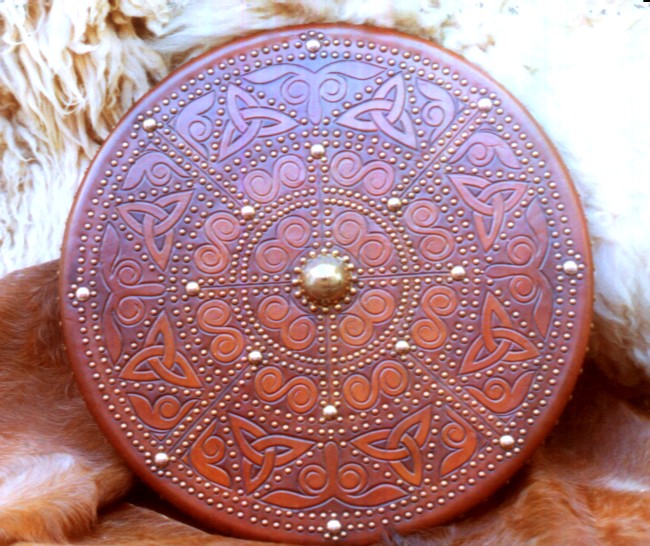|
-
17th June 11, 07:34 PM
#1
 Originally Posted by Donnachaidh

I've jist googled the word 'tarje' from Norwegian and Danish...
I have the sound of the word, but not the literal meaning.
The short round shield was also called a buckler.
G
Bucklers were a small round shield, as well, but they were typically all-metal construction. A buckler looks essentially like this:

A targe looks like this:

It's wood covered with leather.
And speaking of pronounciation problems- it took me almost a year to actually meet someone with the name Donnachaidh so I could find out how that one was pronounced!! She and I have since become good friends. I'm making a wood and leather camp stool for my Donnachaidh friend at the moment!
"Two things are infinite- the universe, and human stupidity; and I'm not sure about the universe." Albert Einstein.
-
-
17th June 11, 07:37 PM
#2
That's some pretty leatherwork. Did you make it, Nighthawk?
--dbh
When given a choice, most people will choose.
-
-
17th June 11, 07:39 PM
#3
 Originally Posted by piperdbh

That's some pretty leatherwork. Did you make it, Nighthawk?
Nope, not yet! I found that and saved it, though, because it gives me ideas for my next one!! I love the way the trinity knots are integrated, but I'm not sure I like the figure 8 designs.
"Two things are infinite- the universe, and human stupidity; and I'm not sure about the universe." Albert Einstein.
-
-
17th June 11, 08:33 PM
#4
 Originally Posted by Nighthawk

Bucklers were a small round shield, as well, but they were typically all-metal construction. A buckler looks essentially like this:

A targe looks like this:

It's wood covered with leather.
And speaking of pronounciation problems- it took me almost a year to actually meet someone with the name Donnachaidh so I could find out how that one was pronounced!! She and I have since become good friends. I'm making a wood and leather camp stool for my Donnachaidh friend at the moment!
As I understand it, usually a buckler was a tad smaller than the targe - 6"-18" vs 15"-24". The buckler was used in a bit more active fashion, not just blocking the opponents strokes, but actively parrying them; and since smaller, could be faster. When used offensively, it could strike, almost like a set of brass knuckles.
Geoff Withnell
"My comrades, they did never yield, for courage knows no bounds."
No longer subject to reveille US Marine.
-
Similar Threads
-
By orangehaggis in forum The Celtic Languages
Replies: 1
Last Post: 20th August 10, 04:55 PM
-
By funlvnman in forum Miscellaneous Forum
Replies: 10
Last Post: 15th November 09, 12:28 AM
-
By Tommy Hunt in forum Miscellaneous Forum
Replies: 8
Last Post: 6th April 09, 07:27 PM
-
By isantop in forum Miscellaneous Forum
Replies: 4
Last Post: 7th January 09, 01:17 PM
-
By GMan in forum General Kilt Talk
Replies: 8
Last Post: 17th May 07, 09:48 PM
 Posting Permissions
Posting Permissions
- You may not post new threads
- You may not post replies
- You may not post attachments
- You may not edit your posts
-
Forum Rules
|
|





















Bookmarks